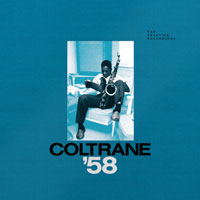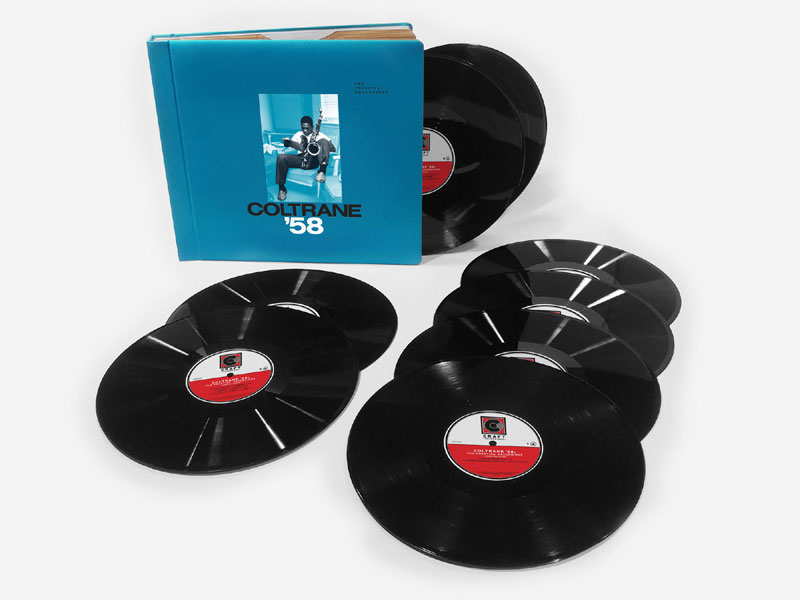John Coltrane • Coltrane '58
 n eight-LP set (five CDs are also available), Coltrane '58
appears to be just another compilation. As the title suggests, it collects all of the
music that John Coltrane recorded for the Prestige label in 1958, the year he became a
headliner of the first rank, after he had kicked his heroin habit and before he played on
a string of classic jazz recordings. However, this set does two things that both Coltrane
fans and jazz archeologists will value. First, it presents all 37 of the cuts from 1958 in
chronological order, beginning with "Lush Life," recorded in January, and ending
with "Time After Time" months later. Second, it collects music from seven
separate albums. So if you want to hear how John Coltrane's style evolved in his early
days, a year before the Kind of Blue sessions and prior to his great early
Atlantic albums Giant Steps and My Favorite Things, you either have to
have all of the albums and reconstruct the sequence yourself or get a copy of Coltrane
'58. n eight-LP set (five CDs are also available), Coltrane '58
appears to be just another compilation. As the title suggests, it collects all of the
music that John Coltrane recorded for the Prestige label in 1958, the year he became a
headliner of the first rank, after he had kicked his heroin habit and before he played on
a string of classic jazz recordings. However, this set does two things that both Coltrane
fans and jazz archeologists will value. First, it presents all 37 of the cuts from 1958 in
chronological order, beginning with "Lush Life," recorded in January, and ending
with "Time After Time" months later. Second, it collects music from seven
separate albums. So if you want to hear how John Coltrane's style evolved in his early
days, a year before the Kind of Blue sessions and prior to his great early
Atlantic albums Giant Steps and My Favorite Things, you either have to
have all of the albums and reconstruct the sequence yourself or get a copy of Coltrane
'58.
Of the albums on which this music first appeared -- Soultrane, Settin' the Pace, Black Pearls, John Coltrane, & Kenny Burrell, Lush Life, Bahia and Stardust -- three are early classics, and only three were released before 1960, one coming years after that. On them, Coltrane played with a veritable who's who of the day's jazz luminaries, Red Garland, Donald Byrd, Freddie Hubbard, Paul Chambers, Art Taylor, Jimmy Cobb and Louis Hayes among them. Another interesting fact about this music: Rudy Van Gelder recorded all of it in his Hackensack, New Jersey, home studio, and like Coltrane, Van Gelder was just emerging as an important figure. This music has a strong pedigree in its favor, and it delivers. However, one great obstacle to overcome when listening to this set is the track sequence of the original LPs. Side one of Soultrane, arguably the best known of Coltrane's 1958 albums, begins with the 12-minute "Good Bait," but here that opens side two of the second LP. It follows "You Say You Care," also from Soultrane, where it's the third cut. But once you clear your head of the sequencing, you can begin to hear how the sentimentality of "Lush Life," which opens Coltrane '58, leads naturally to the loping good humor of "Good Bait," which is preface to "Freight Trane" and "Big Paul" on the third LP, which are from Coltrane's album with guitarist Kenny Burrell, the musical high point of his 1958 output for Prestige. Of course, if you want the greatest single Coltrane album from that year, you have to turn to Blue Note, which released Blue Train in 1958 (it was recorded in late 1957). Such parsing of the details of time and place is easy to forget as the tracks roll and Coltrane's voice becomes more burly and self-assured. That sound is part of the fabric of jazz in the late 1950s, but it was radical in its day, amidst the playing of the tenor giants Coltrane was busy supplanting, including Lester Young, Coleman Hawkins and Ben Webster.
While it's easy to sit back and luxuriate in this collection, it's an important artifact for the student of jazz, and I hope its approach is duplicated with other jazz notables. Wouldn't it be interesting to hear the cuts from the Miles Davis Quintet's matched quad -- Walkin', Steamin', Cookin' and Relaxin' -- handled the same way? Coltrane was also part of those sessions from May and October 1956, and hearing the cuts in chronological order would be a revelation. A spin-off of Concord Music, Craft Recordings issues individual albums, but it's projects like Coltrane '58 and the previously released (and sold out) Thelonious Monk with John Coltrane: The Complete 1957 Riverside Recordings that are its heart, given the label's access to the full Fantasy, Rounder, Stax, Milestone, Prestige, Riverside, Specialty, Sugar Hill, Vanguard and Vee-Jay catalogues. While all of the music on Coltrane '58 was remastered from the original analog tapes, the lacquers for the LPs, which were pressed at RTI, were cut from 24-bit/192kHz digital transfers. I have "deep groove" originals of a couple titles, but their noise makes cut-to-cut sonic comparison difficult. However, the sound of Coltrane '58 is as good or better than that of the XRCDs, gold CDs and SACDs of the titles I own. The set's packaging is also impressive: a linen-wrapped portfolio with individual outer and inner sleeves for the LPs. The integral 40-page booklet is difficult to curl up with but has extensive liner notes by jazz historian Ashley Kahn and period photographs of Coltrane and his collaborators, including some taken by Blue Note co-founder Francis Wolff. Some of what made John Coltrane the central figure he
became was who he played with -- especially Miles Davis and Thelonious Monk -- and while
so many of the albums that followed his 1958 recordings are undeniable classics, the music
on Coltrane '58 sets the stage for the musician that was yet to come, and it has
many moments of resplendent, sublime beauty. Hearing this music in the sequence in which
it was recorded gives greater insight into the man who made it. Coltrane '58 is a
great idea carefully and lavishly executed. |
|||||||||||||||||||||||||||||

